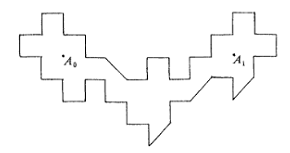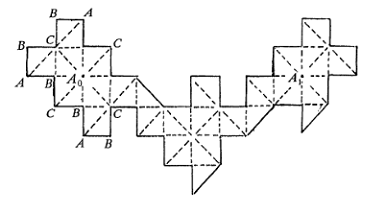===Open Problem #3===
Welcome to Open Problem #3! This problem is rather different than the last two, so if you haven't jumped in yet, now is a very good time to do so! You'll find artistic imagination to be just as useful as mathematics.
It's possible to design a polygonal billiard table such that there are two points that can never connect with one "shot". That is, it's possible to set up a ball in one place and a hole at another such that if the ball is hit once and reflects and unlimited number of times, it will never reach the hole.
(This assumes geometric purity: the "ball" has no mass and the "ball" and "hole" are considered single points. Also, if the ball hits a vertex point as opposed to a side then the reflections are absorbed.)
This has been done with a 26-sided table and a 24-sided table. However, it is unknown if 24 sides is the minimum.
Problem #1: Make a different billiard table that fulfills the above conditions, with any number of sides.
Problem #2: Either prove that 24 sides is the minimum or provide a counterexample.
Problem #1 should be considered truly open there aren't many examples, and creativity is encouraged, even if the number of sides is high.
In addition to tackling the problems above, an excellent contribution to this project would be to make a computer program that allows playing with different configurations and seeing what happens with the reflection.
In order to make it easier to post solutions, I've rendered Problem #1 as a problem to solve in the group. Post any images you might create there.
Before you start, you should study the example below, which was the first given to show that that the no-reflections-pair setup with a polygon was possible.

It comes from a paper by George W. Tokarsky. The proof is fairly short, but requires an intermediate proof.
Lemma: Prove that, starting at the marked vertex of the billiard table shown (shaped like an isosceles triangle), it is impossible to hit a ball that reflects back to where it started (given any number of reflections).
I've posted this as a problem to solve.
Knowing the Lemma, this proof then follows:

If there were a pool shot from to the initial path must pass through the interior of one of the eight triangles surrounding Let us call this triangle As in the lemma, a pool shot from to would correspond or fold up to a pool shot from to of which is impossible.
Update: I highly recommend checking this solution from David Vreken which includes some new diagrams that work and explain a general method.
Quick update on Open Problem #2: I have rendered the text from the proof the group made into a PDF file suitable for publication, using the official American Mathematical Society format. I'm going to make a few review passes first before posting it.
Easy Math Editor
This discussion board is a place to discuss our Daily Challenges and the math and science related to those challenges. Explanations are more than just a solution — they should explain the steps and thinking strategies that you used to obtain the solution. Comments should further the discussion of math and science.
When posting on Brilliant:
*italics*or_italics_**bold**or__bold__paragraph 1
paragraph 2
[example link](https://brilliant.org)> This is a quote# I indented these lines # 4 spaces, and now they show # up as a code block. print "hello world"\(...\)or\[...\]to ensure proper formatting.2 \times 32^{34}a_{i-1}\frac{2}{3}\sqrt{2}\sum_{i=1}^3\sin \theta\boxed{123}Comments
We're mentioned in Numberphiles video !
For problem 1, a simple solution will be that of a circle with a hole in the center and the starting position anywhere else on the circle. Unless the ball is shot directly into the hole, the ball would not enter the hole. Is this allowed?
Log in to reply
Our problem is specifically with polygonal tables. When curved sides are allowed we can get entire chunks of the table that can't reach each other.
I know a better solution, make a figure 8 table and the ball won’t be able to go to the other side of the table 😎
Anyways, if you shoot the ball directly away from the hole, it would bounce and go in, as it would hit at a perpendicular angle.
Log in to reply
"(This assumes geometric purity: the "ball" has no mass and the "ball" and "hole" are considered single points. Also, if the ball hits a vertex point as opposed to a side then the reflections are absorbed.)"
So no, it won't work.
On the computer software side of things, I might have a shot off programming something at the weekend. I found this if anyone wants to play around with the 26-gon. Wolfram
Log in to reply
Looks promising!
It does not need to be a regular polygon, right?
Log in to reply
Correct. (The examples given definitely are not.)
Log in to reply
For some reason I couldn´t see the examples before, thank you!
Log in to reply
Espescially study what's going on with the last picture -- once you figure it out, it isn't too hard to make your own. (It's hard to make one with less sides than 24, though!)
I think we should definitely be able to connect the two points with a single shot in a regular polygon.
Is the lemma also valid for a non-right isosceles triangle?
Log in to reply
Nevermind it definitely doesn't hold in the case of a equalateral triangle.
Log in to reply
Could you post ("Is this valid for a non-right isosceles triangle") that as a problem in the group? (Then set the solution to "no" and you can your solution there if you like.)
Log in to reply
Then we can shoot along one of the sides! It doesn’t violate the “Also, if the ball hits a vertex point as opposed to a side then the reflections are absorbed” rule!
Log in to reply
Sorry I don't understand how you can deduce shooting along the sides from it not holding for non right isoceles triangles
Log in to reply
Sorry for late response. And never mind, I misunderstood.
If you shoot the ball straight up, shouldnt it return?
Log in to reply
No as it hits the vertex. The problem states that if the ball hits a vertex reflections are absorbed.
Now it does
@Jason Dyer I’m not sure what you have on problem 2, but I have a counter example of 21 sides and an almost complete sketch for a proof of minimality. Please let me take a look on that pdf of yours :)